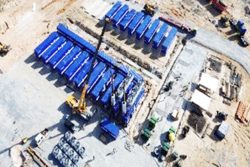Dear Editor,
The National Drainage and Irrigation Authority (NDIA) is responsible for drainage and irrigation in Region Two. It is to ensure that structures involved in this process are properly protected and maintained, and lands, including reserves, are not used and abused contrary to the Drainage and Irrigation Act. It is regrettable that in Region Two this has not been happening.
Permission was granted to rear animals on the high level dam at Evergreen by the Works, Agriculture and D & I Committee of the Regional Council on March 7, 2018, and confirmed by a letter signed by the Regional Vice Chairman and the Regional Engineer of the NDIA in Region Two. (The circular, which was carbon copied to the Regional Vice Chairman of Region Two and Commander ‘G’ Division, Guyana Police Force, Region Two, showing the details, was attached).
The D & I Department has stated that the public is advised, in accordance with Section 26 of the D & I Act, “all lands within twelve feet of the toe of any dam or within a distance of any part of any work… shall vest in the authority free from any encumbrance and shall be the property of the authority.” (The circular, of the NDIA notice with regards to Drainage Reserve. Section 61 of the Act further states, “that any person who hinders repairs of any structures of NDIA shall be liable to a fine and a term of imprisonment,” was attached)
It would seem that the centralised decisions of D & I are not being carried out in the region. People are now occupying and building on D & I reserves, and it will become difficult to remove them in the future. The regional body must not make decisions on D & I lands which run contrary to Sections of the D & I Act.
I would like to point out the Anna Regina Town Council (ARTC) is exploiting poor people using reserves from the drainage trench and roads.
At Anna Regina, there is a road which carries you to the Mainstay Lake. The South side of this road has a twenty-foot reserve. Ten feet of this reserve belongs to the road and ten feet to the drainage trench. With the agreement of the farmers who have rice fields on the same side of the road, some unemployed persons have weeded the reserve, removed a lot of garbage and planted kitchen gardens.
In an Agreement of Tenancy with the Mayor and Town Council (attached) one Mohamed Abrahim is being charged $10,000 for a portion of land measuring 400 ft x 20 ft (8000 sq. ft.), which is less than one fifth of an acre (one acre = 43,560 sq ft), while the cost of rental of rice land is $1,000 per acre. To rent land at such a price to poor unemployed farmers – equivalent to that of ten acres of rice lands – is highly exploitative. The Department of Lands and Surveys and D & I should intervene in this matter to bring some modicum of decency.
One clause in the agreement states that the land can be used for cattle rearing. The cattle damage parapets of trenches and even reach further to damage farmers’ crops. Sometimes farmers have to spray their 18ft reserve to keep cattle away. In this case the council is indirectly damaging farmers’ reserves and crops.
Rice farmers pay the Waters Users Association a fee of $10,000 for a ten acre plot. This fee is to clean, maintain, supply and drain water to the rice farms. Ten feet of this reserve on both sides of the fence allow excavators to clean the trench. The town council does not have the right to rent out the land. In fact, only the Department of Lands and Surveys and D & I should make this decision.
Most of the persons using lands would not abide by the scope of agreement as is evidenced at this point in time.
Mr Flatts and officers of the NDIA have been making vast improvements in the D & I systems. We are glad to hear about some new pumps that will be coming. However, the NDIA should ensure that centralised decisions are adhered to in the regions, especially in Region Two.
Yours faithfully,
Nazir Mohamed









